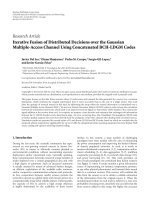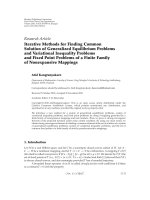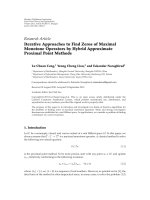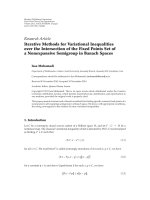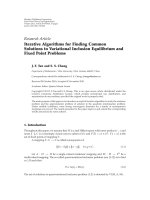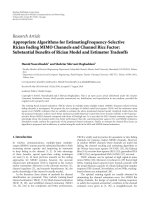Báo cáo hóa học: " Research Article Iterative Algorithms for Nonexpansive Mappings" potx
Bạn đang xem bản rút gọn của tài liệu. Xem và tải ngay bản đầy đủ của tài liệu tại đây (491.68 KB, 10 trang )
Hindawi Publishing Corporation
Fixed Point Theory and Applications
Volume 2008, Article ID 384629, 10 pages
doi:10.1155/2008/384629
Research Article
Iterative Algorithms for Nonexpansive Mappings
Yeong-Cheng Liou
1
and Yonghong Yao
2
1
Department of Information Management, Cheng Shiu University,
Kaohsiung 833, Taiwan
2
Department of Mathematics, Tianjin Polytechnic University, Tianjin 300160, China
Correspondence should be addressed to Yeong-Cheng Liou, simplex
Received 13 September 2007; Accepted 25 November 2007
Recommended by Massimo Furi
We suggest and analyze two new iterative algorithms for a nonexpansive mapping T in Banach
spaces. We prove that the proposed iterative algorithms converge strongly to some fixed point of T.
Copyright q 2008 Y C. Liou and Y. Yao. This is an open access article distributed under the Creative
Commons Attribution License, which permits unrestricted use, distribution, and reproduction in
any medium, provided the original work is properly cited.
1. Introduction
Let E be a real Banach space, C a nonempty closed convex subset of E,andT : C → C a
nonexpansive mapping; namely,
Tx − Ty≤x − y, 1.1
for all x, y ∈ C. We use FT to denote the set of fixed points of T,thatis,FT{x ∈ C : Tx
x}. Throughout the paper, we assume that FT
/
∅.
Construction of fixed points of nonlinear mappings is an important and active research
area. In particular, iterative methods for finding fixed points of nonexpansive mappings have
received a vast investigation; see 1–28.
It is well known that the Picard iteration x
n1
Tx
n
··· T
n1
x of the mapping T at
a point x ∈ C may, in general, not behave well. This means that it may not converge even in
the weak topology. One way to overcome this difficulty is to use Mann’s iteration method that
produces a sequence {x
n
} via the recursive manner:
x
n1
α
n
x
n
1 − α
n
Tx
n
,n≥ 0, 1.2
where the initial guess x
0
∈ C is chosen arbitrarily. For example, Reich 9 proved that if E is a
uniformly convex Banach space with a Frechet differentiable norm and if {α
n
} is chosen such
2 Fixed Point Theory and Applications
that
∞
n1
α
n
1 − α
n
∞, then the sequence {x
n
} defined by 1.2 converges weakly to a fixed
point of T. However, this scheme has only a weak convergence even in a Hilbert space.
Some attempts to construct iteration method so that strong convergence is guaranteed
have recently been made. For a sequence {α
n
} of real numbers in 0, 1 and an arbitrary u ∈ C,
let the sequence {x
n
} in C be iteratively defined by x
0
∈ C,
x
n1
α
n
u
1 − α
n
Tx
n
. 1.3
The iterative method 1.3 is now referred to as the Halpern iterative method. The interest and
importance of Halpern iterative method lie in the fact that strong convergence of the sequence
{x
n
} is achieved under certain mild conditions on parameter {α
n
} in a general Banach space.
Recently, Su and Li 21 introduced the following two new iterative algorithms for a
nonexpansive mapping T:forfixedu ∈ C, let the sequences {x
n
} and {y
n
} be generated by
x
n1
α
n
u
1 − α
n
T
β
n
u
1 − β
n
x
n
, 1.4
y
n1
α
n
β
n
u
1 − β
n
Ty
n
1 − α
n
1
n 1
n
i0
T
i
y
n
, 1.5
respectively. Su and Li proved that the sequences {x
n
} and {y
n
} converge strongly to some
fixed point of T under some assumptions. Subsequently, Liu and Li 22 extended and im-
proved the corresponding results of Su and Li 21. But we note that all of the above results
have imposed some additional assumptions on parameters. Please see 21, 22 for more details.
Motivated and inspired by the above works, in this paper we construct two new itera-
tive algorithms for approximating fixed points of a nonexpansive mapping T. We prove that
the proposed iterative algorithms converge strongly to a fixed point of T under some mild
conditions.
2. Preliminaries
Let E be a real Banach space with its dual E
∗
.LetS {x ∈ E : x 1} denote the unit sphere
of E. The norm on E is said to be G
ˆ
ateaux differentiable if the limit
lim
t→0
x ty−x
t
2.1
exists for each x, y ∈ S and in this case E is said to be smooth. E is said to have a uniformly
Frechet differentiable norm if the limit 2.1 is attained uniformly for x, y ∈ S and in this case E
is said to be uniformly smooth. It is well known that if E is uniformly smooth, then the duality
map is norm-to-norm uniformly continuous on bounded subsets of E.
Let C ⊂ E be closed convex and P a mapping of E onto C. Then, P is said to be sunny
if PPx tx − Px Px, for all x ∈ E and t ≥ 0. A mapping P of E into E is said to be a
retraction if P
2
P. If a mapping P is a retraction, then Pz z for every z ∈ RP,whereRP
is the range of P. A subset C of E is said to be a sunny nonexpansive retract of E if there exists
a sunny nonexpansive retraction of E onto C and it is said to be a nonexpansive retract of E if
there exists a nonexpansive retraction o f E onto C.IfE H, the metric projection P
C
is a sunny
nonexpansive retraction from H to any closed convex subset of H.
Y C. Li ou and Y. Yao 3
We need the following lemmas for proving our main results.
Lemma 2.1 see 16. Let E be a real Banach space and J the normalized duality map on E. Then, for
any given x, y ∈ E, the following inequality holds:
x y
2
≤x
2
2
y, jx y
, ∀jx y ∈ Jx y. 2.2
Lemma 2.2 see 20. Let {x
n
} and {z
n
} be bounded sequences in a Banach space E and let {α
n
}
be a sequence i n 0, 1 which satisfies the condition 0 < lim inf
n→∞
α
n
≤ lim sup
n→∞
α
n
< 1. Suppose
x
n1
α
n
x
n
1 −α
n
z
n
,n≥ 0,andlim sup
n→∞
z
n1
−z
n
− x
n1
− x
n
≤ 0.Then,lim
n→∞
z
n
−
x
n
0.
Lemma 2.3 see 17. Assume {a
n
} is a sequence of nonnegative real numbers such that a
n1
≤
1 − b
n
a
n
c
n
,n≥ 0,where{b
n
} is a sequence in 0, 1 and {c
n
} is a sequence in R such that
i
∞
n0
b
n
∞,
ii lim sup
n→∞
c
n
/b
n
≤ 0 or
∞
n0
|c
n
| < ∞.
Then, lim
n→∞
a
n
0.
Lemma 2.4 see 17. Let C be a nonempty closed convex subset of a uniformly smooth Banach space
E.LetT : C → C be a nonexpansive mapping with FT
/
∅. Then, there exists a continuous path
t → z
t
, 0 <t<1, satisfying z
t
tu 1 − tTz
t
, for arbitrary but fixed u ∈ C, which converges
strongly to a fixed point of T. Further, if Pu lim
t→0
z
t
, for each u ∈ C,thenP is a sunny nonexpansive
retraction of C onto FT.
Lemma 2.5 see 17. Let C be a nonempty closed convex subset of a uniformly smooth Banach space
E.LetT : C → C be a nonexpansive mapping with FT
/
∅.Let{x
n
}⊂C be a sequence. Suppose
that {x
n
} is bounded and lim
n→∞
x
n
− Tx
n
0.Then,u − Pu,jx
n
− Pu≤0.
3. Main results
Let C be a nonempty closed convex subset of a real uniformly smooth Banach space E.First,
forfixedtwodifferent anchors u, v ∈ C we define x
t
tu 1 − tTx
t
and y
t
tv 1 − tTy
t
.It
follows from Lemma 2.4 that x
t
and y
t
converge strongly to Pu and Pv, respectively. Now we
assume that anchors u and v satisfy condition P: Pu Pv, where P is a sunny nonexpansive
retraction from C onto FT.
Now we introduce the following iterative algorithm: for fixed u, v ∈ C and given x
0
∈ C
arbitrarily, find the approximate solution {x
n
} by
x
n1
α
n
u β
n
x
n
γ
n
T
δ
n
v
1 − δ
n
x
n
, 3.1
where {α
n
}, {β
n
}, {γ
n
},and{δ
n
} are real sequences in 0, 1.
Remark 3.1. Our iterative algorithm 3.1 can be reviewed as an extension of the iterative algo-
rithm 1.4.
Now we state and prove the strong convergence of the iterative algorithm 3.1.
4 Fixed Point Theory and Applications
Theorem 3.2. Let C be a nonempty closed convex subset of a real uniformly smooth Banach space E.
Let T : C → C be a nonexpansive mapping with FT
/
∅. Suppose the sequences {α
n
}, {β
n
}, {γ
n
},
and {δ
n
} in 0, 1 satisfy α
n
β
n
γ
n
1,n≥ 0. Suppose the following conditions are satisfied:
i lim
n→∞
α
n
0 and
∞
n0
α
n
∞;
ii 0 < lim inf
n→∞
β
n
≤ lim sup
n→∞
β
n
< 1;
iii lim
n→∞
δ
n
0 and δ
n
/α
n
≤ M for some constant M ≥ 0.
For fixed anchors u and v satisfying condition (P) and arbitrary given x
0
∈ C, the sequence {x
n
}
defined by 3.1 converges strongly to Pu ∈ FT.
Proof. Setting y
n
δ
n
v 1 − δ
n
x
n
and σ
n
α
n
γ
n
δ
n
.Forp ∈ FT,wehave
x
n1
− p
≤ α
n
u − p β
n
x
n
− p
γ
n
δ
n
v − p
1 − δ
n
x
n
− p
α
n
u − p γ
n
δ
n
v − p
β
n
γ
n
1 − δ
n
x
n
− p
≤ σ
n
max
v − p, u − p
1 − σ
n
x
n
− p
≤ max
u − p, v − p,
x
0
− p
,
3.2
which implies that {x
n
} is bounded.
From 3.1, we write x
n1
β
n
x
n
1 − β
n
z
n
. It is easily seen that
z
n1
− z
n
α
n1
u γ
n1
Ty
n1
1 − β
n1
−
α
n
u γ
n
Ty
n
1 − β
n
α
n1
1 − β
n1
−
α
n
1 − β
n
u
γ
n1
1 − β
n1
Ty
n1
− Ty
n
γ
n1
1 − β
n1
−
γ
n
1 − β
n
Ty
n
.
3.3
It follows that
z
n1
− z
n
≤
α
n1
1 − β
n1
−
α
n
1 − β
n
u
Ty
n
γ
n1
1 − β
n1
Ty
n1
− Ty
n
≤
α
n1
1 − β
n1
−
α
n
1 − β
n
u
Ty
n
γ
n1
1 − β
n1
y
n1
− y
n
.
3.4
At the same time, we note that
y
n1
− y
n
≤
δ
n1
− δ
n
v
x
n
1 − δ
n1
x
n1
− x
n
. 3.5
It follows from 3.4 and 3.5 that
z
n1
− z
n
≤
α
n1
1 − β
n1
−
α
n
1 − β
n
u
Ty
n
γ
n1
1 − β
n1
×
δ
n1
− δ
n
v
x
n
γ
n1
1 − β
n1
x
n1
− x
n
.
3.6
Y C. Li ou and Y. Yao 5
Then, we have
z
n1
− z
n
≤
α
n1
1 − β
n1
−
α
n
1 − β
n
|
u
Ty
n
γ
n1
1 − β
n1
δ
n1
− δ
n
×
v
x
n
α
n1
1 − β
n1
x
n1
− x
n
x
n1
− x
n
,
3.7
which implies that
lim sup
n→∞
z
n1
− z
n
−
x
n1
− x
n
≤ 0. 3.8
From Lemma 2.2 and 3.8, we obtain lim
n→∞
z
n
− x
n
0. Consequently, lim
n→∞
x
n1
− x
n
lim
n→∞
1 − β
n
z
n
− x
n
0.
On the other hand, we observe that
x
n
− Tx
n
≤
x
n1
− x
n
x
n1
− Tx
n
≤
x
n1
− x
n
α
n
u − Tx
n
β
n
x
n
− Tx
n
γ
n
Ty
n
− Tx
n
≤
x
n1
− x
n
α
n
u − Tx
n
β
n
x
n
− Tx
n
γ
n
δ
n
v − x
n
,
3.9
that is,
x
n
− Tx
n
≤
1
1 − β
n
x
n1
− x
n
α
n
u − Tx
n
γ
n
δ
n
v − x
n
−→ 0. 3.10
By Lemma 2.5 and 3.10, we can obtain
lim sup
n→∞
u − Pu,j
x
n
− Pu
≤ 0, lim sup
n→∞
v − Pv,j
x
n
− Pv
≤ 0. 3.11
Since y
n
− x
n
δ
n
v − x
n
→0andPu Pv,wehave
lim sup
n→∞
u − Pu,j
x
n
− Pu
≤ 0, lim sup
n→∞
v − Pu,j
y
n
− Pu
≤ 0. 3.12
Finally, we show that x
n
→ Pu. As a matter of fact, we have
x
n1
− Pu
2
≤
β
n
x
n
− Pu
γ
n
Ty
n
− Pu
2
2α
n
u − Pu,j
x
n1
− Pu
≤ β
n
x
n
− Pu
2
γ
n
y
n
− Pu
2
2α
n
u − Pu,j
x
n1
− Pu
≤ β
n
x
n
− Pu
2
γ
n
1 − δ
n
x
n
− Pu
2
2δ
n
v − Pu,j
y
n
− Pu
2α
n
u − Pu,j
x
n1
− Pu
≤
1 − α
n
x
n
− Pu
2
2δ
n
v − Pu,j
y
n
− Pu
2α
n
u − Pu,j
x
n1
− Pu
1 − α
n
x
n
− Pu
2
α
n
λ
n
,
3.13
where λ
n
2δ
n
/α
n
v−Pu,jy
n
−Pu2u−Pu,jx
n1
−Pu. It is easy to see from 3.12 that
lim sup
n→∞
λ
n
≤ 0. Lemma 2.3 and 3.13 ensure that x
n
→ Pu. This completes the proof.
6 Fixed Point Theory and Applications
Corollary 3.3. Let C be a nonempty closed convex subset of a real uniformly smooth Banach space E.
Let T : C → C be a nonexpansive mapping with FT
/
∅. Suppose that the sequences {α
n
}, {β
n
},
{γ
n
},and{δ
n
} in 0, 1 satisfy α
n
β
n
γ
n
1,n≥ 0. Suppose the following conditions are satisfied:
i lim
n→∞
α
n
0 and
∞
n0
α
n
∞;
ii 0 < lim inf
n→∞
β
n
≤ lim sup
n→∞
β
n
< 1;
iii lim
n→∞
δ
n
0 and δ
n
/α
n
≤ M for some constant M ≥ 0.
For fixed anchor u and arbitrary x
0
∈ C, define the sequence {x
n
} as
x
n1
α
n
u β
n
x
n
γ
n
T
δ
n
u
1 − δ
n
x
n
. 3.14
Then, the sequence {x
n
} converges strongly to Pu ∈ FT.
Finally, we introduce another iterative algorithm: for fixed anchor u ∈ C and given x
0
∈
C arbitrarily, find the approximate solution {x
n
} by the iterative algorithm:
x
n1
β
n
x
n
1 − β
n
A
n
y
n
,
y
n
α
n
u
1 − α
n
Tx
n
,n≥ 0,
3.15
where A
n
1/n 1
n
i0
T
i
.
Now we prove the strong convergence of the iterative algorithm 3.15.
Theorem 3.4. Let C be a nonempty closed convex subset of a real uniformly smooth Banach space E.
Let T : C → C be a nonexpansive mapping with FT
/
∅.Let{α
n
} and {β
n
} be the sequences in 0, 1.
Suppose the following conditions are satisfied:
i lim
n→∞
α
n
0;
ii
∞
n0
α
n
∞;
iii 0 < lim inf
n→∞
β
n
≤ lim sup
n→∞
β
n
< 1.
For arbitrary x
0
∈ C, the sequence {x
n
} defined by 3.15 converges strongly to Pu ∈ FT, where P is
a sunny nonexpansive retraction from C onto FT.
Proof. First, we note that A
n
: C → C is nonexpansive. In fact, for any x, y ∈ C,wehavethat
A
n
x − A
n
y
1
n 1
n
i0
T
i
x −
1
n 1
n
i0
T
i
y
≤
1
n 1
n
i0
x − y x − y.
3.16
At the same time, for any x ∈ C,
A
n1
x − A
n
x
1
n 2
n1
i0
T
i
x −
1
n 1
n
i0
T
i
x
≤
1
n 1n 2
n
i0
T
i
x
1
n 2
T
n1
x
.
3.17
Now we show that {x
n
} is bounded. Indeed, for p ∈ FT,wehave
y
n
− p
≤ α
n
u − p
1 − α
n
Tx
n
− p
≤ α
n
u − p
1 − α
n
x
n
− p
.
3.18
Y C. Li ou and Y. Yao 7
Hence, we have
x
n1
− p
≤ β
n
x
n
− p
1 − β
n
A
n
y
n
− p
≤ β
n
x
n
− p
1 − β
n
y
n
− p
≤
1 − α
n
1 − β
n
x
n
− p
1 − β
n
α
n
u − p≤max
x
n
− p
, u − p
.
3.19
Now, an induction yields
x
n
− p
≤ max
x
0
− p
, u − p
. 3.20
Therefore, {x
n
} is bounded, so is {Tx
n
}.
Setting x
n1
β
n
x
n
1 − β
n
z
n
,wherez
n
A
n
y
n
for all n ≥ 0, then we have that
z
n1
− z
n
≤
A
n1
y
n1
− A
n
y
n1
A
n
y
n1
− A
n
y
n
≤
A
n1
y
n1
− A
n
y
n1
y
n1
− y
n
.
3.21
Observe that
y
n1
− y
n
α
n1
− α
n
u 1 − α
n1
Tx
n1
− Tx
n
α
n
− α
n1
Tx
n
≤
α
n1
− α
n
u
Tx
n
1 − α
n1
x
n1
− x
n
.
3.22
So, we get
z
n1
− z
n
−
x
n1
− x
n
≤
A
n1
y
n1
− A
n
y
n1
α
n1
− α
n
u
Tx
n
.
3.23
This together with 3.17 implies that
lim sup
n→∞
z
n1
− z
n
−
x
n1
− x
n
≤ 0.
3.24
Consequently, from Lemma 2.2,weobtain
lim
n→∞
z
n
− x
n
0,
lim
n→∞
x
n1
− x
n
lim
n→∞
1 − β
n
x
n
− z
n
0.
3.25
Next, we show that
lim
n→∞
x
n
− Tx
n
0. 3.26
We note from 23 that
z
n
− Tz
n
−→ 0. 3.27
Therefore, from 3.25,and3.27,wehave
x
n
− Tx
n
≤
x
n1
− x
n
x
n1
− Tx
n
≤
x
n1
− x
n
x
n1
− z
n
z
n
− Tx
n
≤
x
n1
− x
n
x
n1
− z
n
z
n
− Tz
n
Tz
n
− Tx
n
≤
x
n1
− x
n
x
n1
− z
n
z
n
− Tz
n
z
n
− x
n
−→ 0.
3.28
8 Fixed Point Theory and Applications
From 3.28 and Lemma 2.5,wehave
lim sup
n→∞
u − Pu,j
x
n
− Pu
≤ 0. 3.29
Noting that
y
n
− x
n
≤ α
n
u − x
n
1 − α
n
x
n
− Tx
n
−→ 0, 3.30
hence,
lim sup
n→∞
u − Pu,j
y
n
− Pu
≤ 0. 3.31
Finally, applying Lemma 2.1 to 3.15,weobtain
x
n1
− Pu
2
≤ β
n
x
n
− Pu
2
1 − β
n
z
n
− Pu
2
≤ β
n
x
n
− Pu
2
1 − β
n
y
n
− Pu
2
β
n
x
n
− Pu
2
1 − β
n
α
n
u − Pu
1 − α
n
Tx
n
− Pu
2
≤ β
n
x
n
− Pu
2
1 − β
n
1 − α
n
Tx
n
− Pu
2
2α
n
u − Pu,j
y
n
− Pu
≤ β
n
x
n
− Pu
2
1 − β
n
1 − α
n
x
n
− Pu
2
2α
n
u − Pu,j
y
n
− Pu
1 −
1 − β
n
α
n
x
n
− Pu
2
2
1 − β
n
α
n
u − Pu,j
y
n
− Pu
.
3.32
By Lemma 2.3 and 3.32, we conclude that x
n
→ Pu. This completes the proof.
Remark 3.5. We drop the imposed assumptions in 21:
∞
n1
|α
n
− α
n−1
| < ∞ and
∞
n1
δ
n
< ∞
on parameters {α
n
} and {δ
n
}, respectively.
Acknowledgments
The authors are extremely grateful to the anonymous referees for their useful comments and
suggestions. The first author was partially supported by Grant NSC 96-2221-E-230-003. The
second author was partially supported by National Natural Science Foundation of China Grant
10771050.
References
1 F. E. Browder and W. V. Petryshyn, “Construction of fixed points of nonlinear mappings in Hilbert
space,” Journal of Mathematical Analysis and Applications, vol. 20, no. 2, pp. 197–228, 1967.
2 C. Byrne, “A unified treatment of some iterative algorithms in signal processing and image recon-
struction,” Inverse Problems, vol. 20, no. 1, pp. 103–120, 2004.
3 C. I. Podilchuk and R. J. Mammone, “Image recovery by convex projections using a least-squares
constraint,” Journal of the Optical Society of America A, vol. 7, no. 3, pp. 517–521, 1990.
Y C. Li ou and Y. Yao 9
4 P. L. Combettes, “The convex feasibility problem in image recovery,” in Advances in Imaging and Elec-
tron Physics, P. Hawkes, Ed., vol. 95, pp. 155–270, Academic Press, New York, NY, USA, 1996.
5 P. L. Combettes, “On the numerical robustness of the parallel projection method in signal synthesis,”
IEEE Signal Processing Letters, vol. 8, no. 2, pp. 45–47, 2001.
6 T H. Kim and H K. Xu, “Robustness of Mann’s algorithm for non-expansive mappings,” Journal of
Mathematical Analysis and Applications, vol. 327, no. 2, pp. 1105–1115, 2007.
7 H. W. Engl and A. Leit
˜
ao, “A Mann iterative regularization method for elliptic Cauchy problems,”
Numerical Functional Analysis and Optimization, vol. 22, no. 7-8, pp. 861–884, 2001.
8 D. Youla, “Mathematical theory of image restoration by the method of convex projection,” in Image
Recovery Theory and Applications, H. Stark, Ed., pp. 29–77, Academic Press, Orlando, Fla, USA, 1987.
9 S. Reich, “Weak convergence theorems for non-expansive mappings in Banach spaces,” Journal of
Mathematical Analysis and Applications, vol. 67, no. 2, pp. 274–276, 1979.
10 A. Genel and J. Lindenstrauss, “An example concerning fixed points,” Israel Journal of Mathematics,
vol. 22, no. 1, pp. 81–86, 1975.
11 B. Halpern, “Fixed points of nonexpanding maps,” Bulletin of the American Mathematical Society,vol.73,
pp. 957–961, 1967.
12 P L. Lions, “Approximation de points fixes de contractions,” Comptes Rendus de l’Acad
´
emie des Sciences.
S
´
eries A et B, vol. 284, no. 21, pp. A1357–A1359, 1977.
13 R. Wittmann, “Approximation of fixed points of non-expansive mappings,” Archiv der Mathematik,
vol. 58, no. 5, pp. 486–491, 1992.
14 S. Reich, “Some problems and results in fixed point theory,” in Topological Methods in Nonlinear Func-
tional Analysis (Toronto, Ont., 1982),vol.21ofContemporary Mathematics, pp. 179–187, American Math-
ematical Society, Providence, RI, USA, 1983.
15 N. Shioji and W. Takahashi, “Strong convergence of approximated sequences for non-expansive map-
pings in Banach spaces,” Proceedings of the American Mathematical Society, vol. 125, no. 12, pp. 3641–
3645, 1997.
16 H K. Xu, “Another control condition in an iterative method for non-expansive mappings,” Bulletin of
the Australian Mathematical Society, vol. 65, no. 1, pp. 109–113, 2002.
17
H K. Xu, “Viscosity approximation methods for non-expansive mappings,” Journal of Mathematical
Analysis and Applications, vol. 298, no. 1, pp. 279–291, 2004.
18 Y. Yao and M. A. Noor, “On viscosity iterative methods for variational inequalities,” Journal of Mathe-
matical Analysis and Applications, vol. 325, no. 2, pp. 776–787, 2007.
19 H K. Xu, “Iterative algorithms for nonlinear operators,” Journal of the London Mathematical Society,
vol. 66, no. 1, pp. 240–256, 2002.
20 T. Suzuki, “Strong convergence of Krasnoselskii and Mann’s type sequences for one-parameter non-
expansive semigroups without Bochner integrals,” Journal of Mathematical Analysis and Applications,
vol. 305, no. 1, pp. 227–239, 2005.
21 Y. Su and S. Li, “Strong convergence theorems on two iterative method for non-expansive mappings,”
Applied Mathematics and Computation, vol. 181, no. 1, pp. 332–341, 2006.
22 Y. Liu and Z. Li, “Strong convergence theorems in reflexive Banach spaces for non-expansive map-
pings,” Applied Mathematics and Computation, vol. 193, no. 2, pp. 438–445, 2007.
23 R. E. Bruck, “On the convex approximation property and the asymptotic behavior of nonlinear con-
tractions in Banach spaces,” Israel Journal of Mathematics, vol. 38, no. 4, pp. 304–314, 1981.
24 L C. Zeng and J C. Yao, “Implicit iteration s cheme with perturbed mapping for common fixed points
of a finite family of non-expansive mappings,” Nonlinear Analysis: Theory, Methods & Applications,
vol. 64, no. 11, pp. 2507–2515, 2006.
25 Y C. Liou, Y. Yao, and R. Chen, “Iteration scheme with perturbed mapping for common fixed points
of a finite family of non-expansive mappings,” Fixed Point Theory and Applications, vol. 2007, Article
ID 29091, 10 pages, 2007.
26 Y. Yao, R. Chen, and H. Zhou, “Strong convergence to common fixed points of non-expansive map-
pings without commutativity assumption,” Fixed Point Theory and Applications, vol. 2006, Article
ID 89470, 8 pages, 2006.
10 Fixed Point Theory and Applications
27 Y C. Liou, Y. Ya o, and K. Kimura, “Strong convergence to common fixed points of a finite family of
non-expansive mappings,” Journal of Inequalities and Applications, vol. 2007, Article ID 37513, 10 pages,
2007.
28 S S. Chang, J C. Yao, J. K. Kim, and L. Yang, “Iterative approximation to convex feasibility problems
in Banach space,” Fixed Point Theory and Applications, vol. 2007, Article ID 46797, 19 pages, 2007.

